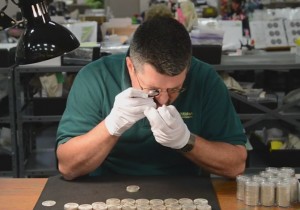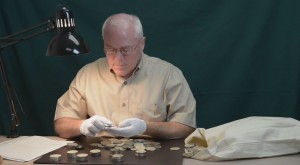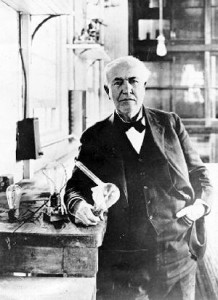Tips from the Pros… on lights for coin collecting

Littleton’s senior coin buyer, Ken Westover, views hundreds of thousands of coins annually. He’s seen here using a swing arm tabletop lamp.
If you’re like most folks, you probably don’t spend too much time thinking about light bulbs or lighting. Let’s face it, we flick a switch and the light works. The only time we really have any concern is when the lights don’t work, or we have to replace a bulb. But, did you know that lighting plays an important part in coin collecting? It’s true. There are specific lighting recommendations just for coin collecting that differ from other crafts or hobbies. In fact, lighting is so important to our coin buyers and graders, that they take their own lights and bulbs with them when they travel to shows or shops!
It’s all about consistency!
To shed some “light” on this topic, I consulted with Ken Westover, one of our senior coin buyers. He looks at hundreds of thousands of coins annually, both at our retail operation and out on the road.

Viewing Tip: Try placing a mat on the desk or tabletop surface. We use a black, brown or other solid colored mat. In addition to keeping dirt and grime off your table, it will also create a neutral, dull background that won’t compete with the coin.
According to Ken, the goal of good lighting in collecting is to create consistency, so you can compare and contrast, recognize detail and see wear and tear on the coin’s surface. He says, “Having a consistent lighting source lets you look at a wide variety of coin types and grades and be comfortable that what you see is truly what you get. For us here, we need to know that all our coins are viewed under the same conditions, because we act as quality control for our customers. Maintaining a standard for lighting means that the conditions of analyzing and determining a grade, do not vary.”
LCC preferred lamps and bulbs
Depending on the time of day or weather, the brightness of a room can vary immensely and this could create dramatic differences in what you actually see on a coin’s surface. At home, you’ll want to set up a consistent environment to view your collection, too. So here are LCC’s official lighting tips for coin collecting.
- Select a quality tabletop lamp – Our entire coin buying and grading team, sorters and retail clerks all use swivel, desktop lights. While you could use a floor lamp or another type, we prefer the versatility of the swivel arm tabletop version. They clasp onto a desk or tabletop, and the swing arm enables you to stretch and bend it up to a 30-36″ reach. This allows you to pull the lamp down and focus the light where you need it, and gives you the ability to see deeply into nooks and crannies of the coins surface. We suggest you position your lamp perpendicular to your desk at a comfortable height approximately 12-18″ above the desk surface.Here at Littleton, we use two brands:
• LEDU Opti series Swing Arm Lamp (LEDL502BK)
• Studio Designs version (model #12021)
Both are inexpensive ($20-$50), durable and carried by a wide array of retailers and office supply stores. -

A fitting tribute – one of the U.S. inventors of the incandescent bulb we know today, was Thomas Edison. He is forever remembered with the 2004 Thomas Edison coin.
Choose an incandescent bulb (75W-100W) – Despite the demise of the incandescent bulb here in America, most numismatic experts still recommend using a 75W-100W incandescent bulb for examining coins. That’s because the lighting of an incandescent is more focused. It allows you to focus the light “pin point” style on an area, rather than having the light spread out or diffused. Without it, you could miss imperfections such as hairlines, blemishes, or other damage. Most of the time, our buyers use a 100W bulb. The exception is when looking at volumes of extremely shiny, Uncirculated coins, or some Proof Sets. In this case, a 75W is swapped out instead.
- Avoid Fluorescents and Halogen lights – With full spectrum, fluorescents and some LED bulbs, the lighting is too soft. This could cause shading or color inconsistencies. Halogens are too harsh and can bring undue attention to nooks and crannies, making them appear more significant than they really are.
- Hold coins perpendicular to the light – When viewing a coin, hold it by the edge, perpendicular to the light source so as to not cause deep shadows. That means holding it directly below your light and tipping your coin to a 45″ angle. Try positioning the coin from 12-16″ away from your eyes. In addition, we recommend creating a coin examining routine or habit of your own that doesn’t vary. View your coins under the same lighting, angle and distance each time. That way you’ll create your own consistency.
If I learned anything in writing this article, it was about the importance of viewing your coins the same way each time – and lighting is key! By creating your own consistent environment to view your collection with recommended lighting, you’ll become better at noticing the subtle nuances of your coins to better understand your collection, and the numismatic hobby.
What’s your take? Do you have any routines when looking at your coins? What do use for lighting?




I didn’t know that lighting would be so important when collecting coins. It makes sense to have good light, but I didn’t think consistency would be an issue. I will try harder to be consistent. Thanks for your post.
Hi Ian, Imagine if you looked at something at noon in the kitchen and then at night under a lamp, there’s bound to be some inconsistencies there for sure. The idea is that if you view your coins with the same lighting each time, you’ll reduce your chances of missing something. Thanks for your comments – Jill
Your link in the Edison picture incorrectly states “2015 Thomas Edison coin”. In fact, it is a 2004.
Thanks for pointing that out Raul, good eye! Happy New Year! -Rick
I really love collecting coins as a hobby, I just kind of fell into it. I am always looking to find the next big thing, like how old of a quarter I can get. I like the tip about having consistent light to see all of the little imperfections on a coin. I need to look into that for my desk.
Hi Luke,
Thanks for commenting. It’s true about the consistent lighting. It’s something you really don’t think about, but when you look at a coin under several different lights you can really see the differences. Happy collecting, and good luck on your quarter quest!
I am just beginning my coin collection, and think your tips on lighting are pretty great! However, I’m not sure why incandescent bulbs are better. I get what you are saying about the light being more focused. However, wouldn’t using an LED light also give you the focused light you need.
Hi James, Welcome to the fabulous world of coin collecting! In reference to lighting, I checked in with our Coin Buying team on this. They said, from a professional standpoint – considering the volume, variety and grades they look at – they prefer the incandescent bulb. It’s brighter (900-1,000 lumens vs. 850) than the LED and more consistent for their overall needs. But, they stressed that it really comes down to consistency and preference. You could use an LED as long as that was what you used time after time. Hope this helps. Happy collecting!
Thanks! I will definitely try to be consistent with my lighting.
Muchas gracias por la información , estoy pir comprar una nueva lámpara, yo uso una pequeña lupa tipo de joyero BAUSCH & LOMB , me acoplo bien , pero que tal son ésas que se ven las monedas en un monitor ? Gracias
Los microscopios electrónicos actuales pueden ser de gran ayuda si tiene problemas de visión o si busca detalles muy finos en monedas, ya que suelen ofrecer una magnificación mucho mayor que una lupa o un cristal de aumento estándar. Lamentamos no poder recomendarle un modelo en particular, pero existen varios modelos disponibles en línea, desde menos de 100 dólares hasta varios cientos para algunos de los más potentes.
Writing from Sao Paulo, Brazil, I had a favored small halogen desk lamp I used for this purpose as it was very useful in helping me see hairlines from old cleanings. I collect historical coins of Latin America (& some other areas) and hairlines can be very characteristic on both gold & silver.
Unfortunately the transformer on my halogen burnt out as it turned out that a hotel only had 220V lines. Thus I need to find a new light and quickly as the semi-annual coin convention is this coming week in Brazil. Just today I looked at lights in a store and it seemed the LED ones showed greater detail in the coins. I won’t be able to repair my halogen one in the short time available. I guess anything would be better than the conference room overhead fluorescents?
I wonder if there are any really good battery powered lamps?
Hi Julius,
Thanks for writing. What a dilemma! Its always best to stay with what you are used to for consistency sake, but we think in this circumstance you are best with the LED over the flourescents. Later, you should be able to find a battery powered desk lamp online or at any office supply store. Good luck at the show!
Thanks very much. I’ll get the LED as it’s also quite portable. It’s my belief that good lighting is perhaps more important than even a good glass when looking at raw coins. I should mention that at shows outside of the USA, you’ll see 99% “raw material”, even in very high end coins which in the USA, haven’t been outside of a slab for the past 30 years.
A glass is easy to buy and deploy but good lighting is much more of a problem, as you then have to bring extension cords, power converters for 220 volts & run all over the conference room looking for outlets. If you ever see someone doing this at a coin show, it’s probably me…